Students must practice these TS Intermediate Maths 1B Solutions Chapter 7 The Plane Ex 7(a) to find a better approach to solving the problems.
TS Inter 1st Year Maths 1B The Plane 7(a)
I.
Question 1.
Find the equation of the plane if the foot of the perpendicular from origin to the plane is (1, 3, – 5). (V.S.A.Q.)
Answer:
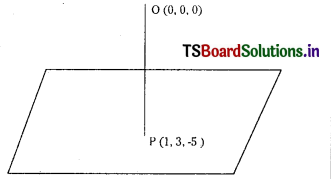
OP is the normal to the plane and plane is passing through P (1, 3, – 5).
Dr’s of normal OP are (1 – 0, 3 – 0, – 5 – 0)
= 1, 3, – 5
Hence equation of the plane is
⇒ a (x – x1) + b (y – y1) + c (z – z1) = 0
⇒ 1(x – 1) + 3(y – 3) – 5(z + 5) = 0
⇒ x + 3y – 5z – 35 = 0
![]()
Question 2.
Reduce the equation x + 2y – 3z – 6 = 0 of the plane to the normal form. (V.S.A.Q.)
Answer:
Equation of the plane is x + 2y – 3z – 6 = 0
⇒ x + 2y – 3z = 6
Dividing both sides by
\(\sqrt{1^2+2^2+(-3)^2}\) = \(\sqrt{1+4+9}\) = √14
We get
\(\left(\frac{1}{\sqrt{14}}\right) x+\left(\frac{2}{\sqrt{14}}\right) y+\left(\frac{-3}{\sqrt{14}}\right) z=\frac{6}{\sqrt{14}}\)
Question 3.
Find the equation of the plane whose intercepts on X, Y, Z – axes are 1,2,4 respectively. (S.A.Q.) (May 2014)
Answer:
Equation of the plane in the intercepts form x y z is \(\frac{x}{a}+\frac{y}{b}+\frac{z}{c}\) = 1, given a = 1, b = 2, c = 4
We have \(\frac{x}{1}+\frac{y}{2}+\frac{z}{4}\) = 1
⇒ 4x + 2y + z = 4
Question 4.
Find the intercepts of the plane 4x + 3y- 2z + 2 = 0 on the co-ordinate axes. (V.S.A.Q.)
Answer:
Given 4x + 3y – 2z = – 2
⇒ – 2x – \(\frac{3}{2}\)y + z = 1
⇒ \(\frac{x}{-\left(\frac{1}{2}\right)}+\frac{y}{-\left(\frac{2}{3}\right)}+\frac{z}{(1)}\)
∴ x – intercept = – \(\frac{1}{2}\), y – intercept = – \(\frac{2}{3}\) and z – intercept = 1.
Question 5.
Find the d.c’s of the normal to the plane x + 2y + 2z – 4 = 0. (V.S.A.Q.) [Mar. ’13, May ’12]
Answer:
Equation of the plane is x + 2y + 2z – 4 = 0
D.r’s of the normal = 1, 2, 2
∴ \(\sqrt{a^2+b^2+c^2}\) = \(\sqrt{1+4+4}\) = 3
∴ D.c’s of the normal are \(\frac{1}{3}, \frac{2}{3}, \frac{2}{3}\)
Question 6.
Find the equation of the plane passing through the point (-2, 1, 3), and having (3, -5, 4) as d.r’s of its normal. (V.S.A.Q.)
Answer:
D.r’s of normal are 3, -5, 4 and since the plane passes through (- 2, 1, 3), we have equation of the plane is
3(x + 2) – 5 (y – 1) + 4 (z – 3) = 0
⇒ 3x + 6-5y + 5 + 4z – 12 = 0
⇒ 3x – 5y + 4z – 1 = 0
![]()
Question 7.
Write the equation of the plane 4x – 4y + 2z + 5 = 0 in the intercept form. (V.S.A.Q.) [March 2012]
Answer:
Equation of the plane is
4x – 4y + 2z + 5 = 0
∴ 4x – 4y + 2z = – 5
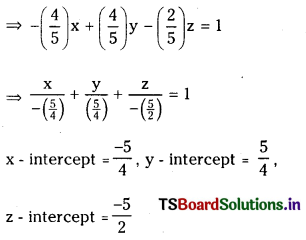
Question 8.
Find the angle between the planes
x + 2y + 2z – 5 = 0 and 3x + 3y + 2z – 8 = 0. (V.S.A.Q.)
Answer:
Equations of the planes are
x + 2y + 2z-5 = 0 ………………. (1)
and 3x + 3y + 2z – 8 = 0 ………………. (2)
If θ is the angle between the planes then by the formula,
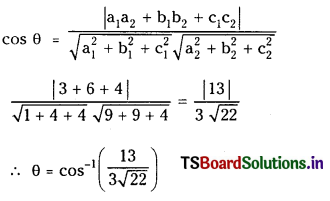
II.
Question 1.
Find the equation of the plane passing through the point (1, 1, 1) and parallel to the plane x + 2y + 3z – 7 = 0. (V.S.A.Q.) [May 2011]
Answer:
Equation of the plane parallel to the given plane x + 2y + 3z – 7 = 0 is of the form x + 2y + 3z + k = 0
If this passes through the point (1, 1, 1) then
1 + 2 + 3 + k = 0 k = – 6
So, the equation of the required plane is
x + 2y + 3z – 6 = 0
![]()
Question 2.
Find the equation of the plane passing through (2, 3, 4) and perpendicular to X-axis. (V.S.A.Q.)
Answer:
If the plane is perpendicular to X-axis then X-axis is a normal to the plane and d.c’s of X-axis are 1, 0, 0.
∴ Equation of the plane is of the form x = k.
Since this passes through (2, 3, 4) we have k = 2.
∴ Equation of the required plane is x = 2.
Question 3.
Show that 2x + 3y + 7 = 0 represents a plane perpendicular to XY-plane. (V.S.A.Q.)
Answer:
Equation of the given plane is 2x + 3y + 7 = 0
Equation of the plane perpendicular to XY plane is z = 0
i. e., 0.x + 0.y + 1.z = 0
Since the two planes are perpendicular by the condition a1a2 + b1b2 + c1c2 = 0 we have 2(0) + 3(0) + 0(1) = 0
∴ Plane 2x + 3y + 7 = 0 is perpendicular to XY – plane.
Question 4.
Find the constant k so that the planes x – 2y + kz = 0 and 2x + 5y – z = 0 are at right angles. Find the equation of the plane through (1, -1,-1) and perpendicular to these planes. (S.A.Q.)
Answer:
Equations of the given planes are x – 2y + kz = 0 and 2x + 5y – z = 0
If the planes are perpendicular then
1(2) + (- 2) (5) + k (-1) = 0
⇒ 2 – 10 – k = 0 ⇒ k = – 8
Equation of the plane is
x – 2y – z = 0 …………….. (1)
and 2x + 5y – z = 0 ………………….. (2)
Equation of the plane passing through (1, – 1, – 1) is of the form
a (x – 1) + b (y + 1) + c (z + 1) = 0 …………………. (3)
If this plane is perpendicular to (1) and (2) then a – 2b – 8c = 0 and 2a + 5b – c = 0
Solving
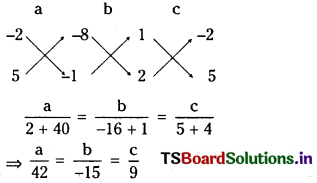
∴ From (3), equation of the required plane is 42 (x – 1) – 15 (y + 1) + 9 (z + 1) = 0
⇒ 42x – 15y + 9z – 48 = 0
![]()
Question 5.
Find the equation of the plane through (- 1, 6, 2) and perpendicular to the join of (1, 2, 3) and (- 2, 3, 4). (S.A.Q.)
Answer:
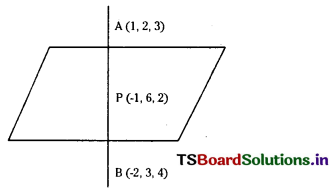
Let A (1, 2, 3) and B (-2, 3, 4) be the given points.
D.r’s of AB are 3, -1,-1.
The line AB is perpendicular to the plane and passing through the point P (- 1, 6, 2).
Then equation of the plane is
3(x + 1) – 1 (y – 6) – 1 (z – 2) = 0
⇒ 3x – y – z + 11 = 0
Question 6.
Find the equation of the plane bisecting the line segment joining (2, 0, 6) and (-6, 2, 4) and perpendicular to it. (S.A.Q.)
Answer:
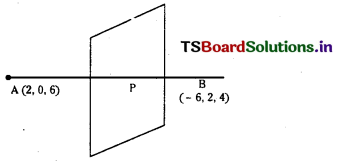
Let A (2, 0, 6) and B(- 6, 2, 4) be the two points.
Then mid point of AB
= \(\left(\frac{2-6}{2}, \frac{0+2}{2}, \frac{6+4}{2}\right)\) = (- 2, 1, 5)
Equation of the plane is perpendicular to AB.
∴ Dr’s of normal to the plane are
2 + 6, 0 – 2, 6 – 4 = 8, – 2, 2
Equation of the required plane is
8(x + 2) – 2(y – 1) + 2 (z – 5) = 0
⇒ 8x – 2y + 2z + 8 = 0
Question 7.
Find the equation of the plane passing through (0,0, – 4) and perpendicular to the line joining the points (1, – 2, 2) and (- 3, 1, – 2). (S.A.Q.)
Answer:
Let A (1, -2, 2) and B (-3, 1, -2) be the given points.
D.r’s of normal to the plane are
(1 + 3, -2 – 1, 2 + 2) = (4, -3, 4)
Equation of the required plane passing through (0, 0 -4) is
4(x – 0) – 3 (y – 0) + 4 (z + 4) = 0
⇒ 4x – 3y + 4z + 16 = 0
Question 8.
Find the equation of the plane through (4, 4, 0) and perpendicular to the planes 2x + y + 2z + 3 = 0 and 3x + 3y + 2z – 8 = 0. (S.A.Q.)
Answer:
The equation of the plane passing through the point (4, 4, 0) is of the form
a (x – 4) + b (y – 4) + c (z – 0) = 0 ………………. (1)
If this is perpendicular to 2x + y + 2z + 3 = 0 and 3x + 3y + 2z – 8 = 0
Then 2a + b + 2c = 0 ……………… (2)
and 3a + 3b + 2c = 0 ……………… (3)
Solving (2) and (3)
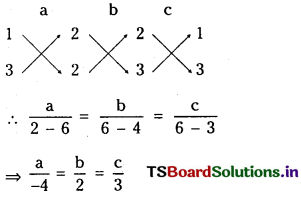
∴ From (1) equation of the required plane is
– 4 (x – 4) + 2 (y – 4) + 3 (z – 0) = 0
⇒ – 4x + 2y + 3z + 8 = 0
⇒ 4x – 2y – 3z – 8 = 0
![]()
III.
Question 1.
Find the equation of the plane through the points (2, 2, – 1), (3, 4, 2), (7, 0, 6). (E.Q.)
Answer:
Equation of the plane passing through (2, 2, – 1) is
a (x – 2) + b (y – 2) + c (z + 1) = 0 ………………. (1)
If this passes through (3, 4, 2) then
a (3 – 2) + b (4 – 2) + c (2 + 1) = 0
⇒ a + 2b + 3c = 0 …………………. (2)
Similarly if the plane passing through (7, 0. 6) is
a (7 – 2) + b (0 – 2) + c (6 + 1) = 0
⇒ 5a – 2b + 7c = 0 ………………… (3)
Solving (2) and (3) we get
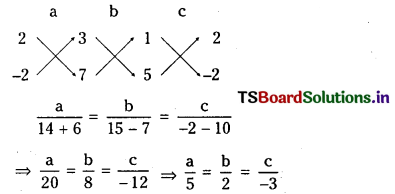
∴ From (1) equation of the required plane is
5 (x – 2) + 2 (y – 2) – 3 (z +1) = 0
⇒ 5x + 2y – 3z – 17 = 0
Question 2.
Show that the points (0, – 1, 0), (2, 1, – 1), (1, 1, 1), (3, 3, 0) are coplanar. (E.Q.)
Answer:
Equation of the plane passing through (0, -1, 0) will be of the form
a (x – 0) + b (y + 1) + c (z – 0) = 0 …………………… (1)
If this passes through (2, 1, – 1) then a (2 – 0) + b (1 + 1) + c (- 1 – 0) = 0
⇒ 2a + 2b – c = 0 …………………… (2)
Similarly if the plane passes through (1, 1, 1) then
a (1 – 0) + b (1 + 1) + c (1 – 0) = 0
⇒ a + 2b + c = 0 ………………….. (3)
Solving (2) and (3),
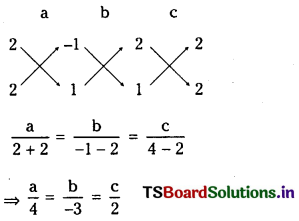
∴ Equation of the plane passing through (0, -1, 0), (2, 1,-1) and (1, 1, 1) is
4 (x – 0) – 3 (y + 1) + 2 (z – 0) = 0 [From (1)]
⇒ 4x – 3y + 2z – 3 = 0 ………………….. (4)
If it passes through (3, 3, 0), then
4(3) – 3(3) + 2 (0) – 3 = 0
Hence the point (3,3,0) also passes through (4) and hence the given points are coplanar.
Question 3.
Find the equation of the plane through (6, -4, 3), (0, 4, -3) and cutting of intercepts whose sum is zero. (E.Q.)
Answer:
Equation of the plane in the intercepts form is \(\frac{x}{a}+\frac{y}{b}+\frac{z}{c}\) = 1.
Given a + b + c = 0
⇒ c = – (a + b)
The plane passes through the points A(6, – 4, 3) and B (0, 4, -3)
Hence, \(\frac{6}{a}-\frac{4}{b}+\frac{3}{c}\) = 1 ……………………. (1)
If this passes through B(0, 4, – 3), then
\(\frac{4}{b}-\frac{3}{c}\) = 1 ……………………….. (2)
Adding (1) and (2); \(\frac{6}{a}\) = 2 ⇒ a = 3
From (2),
\(\frac{4}{b}-\frac{3}{c}\) = 1 ⇒ 4c – 3b = bc
⇒ – 4 (a + b) – 3b = – b (a + b)
⇒ – 4a – 4b – 3b = – ab – b2
⇒ 4a + 7b = ab + b2
Since a = 3 we have 12 + 7b = 3b + b2
⇒ b2 – 4b – 12 = 0 ⇒ (b – 6) (b + 2) = 0
Case – (i): b = 6, then c = -(3 + 6) = – 9
Equation of the plane is \(\frac{x}{3}+\frac{y}{6}-\frac{z}{9}\) = 1
⇒ 6x + 3y – 2z = 18
Case – (ii): b = – 2, then c = -(3 – 2) = – 1
Equation of the plane is \(\frac{x}{3}-\frac{y}{2}+\frac{z}{-1}\) = 1
⇒ \(\frac{x}{3}-\frac{y}{2}+\frac{z}{-1}\) = 1 ⇒ 2x – 3y – 6z = 6
![]()
Question 4.
A plane meets the co-ordinate axes in A, B, C. If the centroid of ∆ABC is (a, b, c). Show that the equation to the plane is \(\frac{x}{a}+\frac{y}{b}+\frac{z}{c}\) = 3. (E.Q.)
Answer:
Suppose α, β, γ be the intercepts of the plane ABC.
Equation of the plane in the intercept form is
\(\frac{x}{\alpha}+\frac{y}{\beta}+\frac{z}{\gamma}\) = 1 ……………… (1)
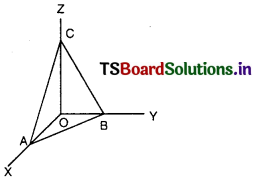
Co-ordinates of A = (α, 0, 0), B = (0, β, 0) and C = (0, 0, γ)
G is the centroid of ∆ABC.
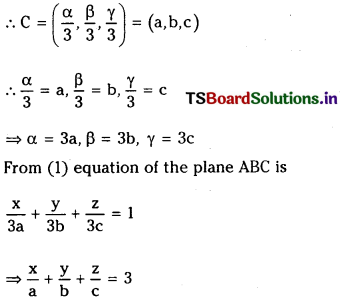
Question 5.
Show that the plane through (1, 1, 1), (1, – 1, 1) and (- 7, – 3, – 5) is parallel to Y – axis. (S.A.Q.)
Answer:
Equation of the plane through A (1, 1, 1) is
a (x – 1) + b (y – 1) + c (z – 1) = 0 ………………… (1)
This plane passes through B (1, – 1, 1) then
0 – 2b + 0 = 0 0 ⇒ b = 0
Equation of XZ plane is y = 0
∴ 0 . x + 1 . y + 0 . z = 0
The required plane is perpendicular to XZ plane and hence parallel to Y – axis.
![]()
Question 6.
Show that the equations ax + by + r = 0, by + cz + p = 0, cz + ax + q = 0 represent planes perpendicular to XY, YZ, ZX planes respectively. (S.A.Q.)
Answer:
Let the equation of the plane be ax + by + c = 0
The d.r’s of normal to the plane are a, b, c Equation of XY plane is z = 0 .-. D.r’s of normal are (0, 0, 1)
∴ a (0) + b (0) + 0 (1) = 0
∴ ax + by + r = 0 represent a plane perpendicular to XY – plane.
Similarly by + cz + p = 0 and cz + ax + q = 0 represent planes perpendicular to YZ – plane, ZX planes respectively.